An Exploration of the Relevance between Sustainable Craft and Service Design Based on a Literature Review Study
Abstract
:1. Introduction
1.1. Research Background and Motives
1.2. Research Aim
2. Research Methodology
2.1. Database and Bibliometric Analysis Methods
2.2. Methodological Procedure
- Characterization of the review’s methodology (including its scope, databases, searches, and inclusion/exclusion criteria);
- Review of the relevant scientific literature (use of search parameters);
- Qualified assessment (inclusion/exclusion summary analysis);
2.2.1. Confirmation of Critical Features
2.2.2. Review of Key Features through Databases
2.2.3. Filtering and Confirmation of Eligible Materials
2.3. Analysis Phase
2.3.1. Trends in Sustainable Craft Publications
2.3.2. Most Influential Sustainable Crafts Subject Areas and Publications
2.3.3. International Network for Sustainable Crafts
2.3.4. The Most Prominent Sustainable Craft Topics and Publications
3. Results and Discussion Phase
3.1. Sustainable Craft Evolution Stages
3.2. Relationship between Sustainability and Craft
3.3. Research Targets
3.3.1. Environmental Aspects
3.3.2. Cultural Aspects
3.3.3. Design Aspects
3.3.4. Technological Aspects
3.3.5. Educational Aspects
3.3.6. Personal Aspects
3.3.7. Emotional Aspects
3.3.8. Consumers Aspects
3.3.9. Economic Aspects
3.3.10. Value Aspects
4. Service Design
4.1. The History of Service Design
4.2. Various Viewpoints on Service Design
4.2.1. About the Service Design Methodology
4.2.2. Tangible and Intangible Aspects of Services
4.2.3. About Service Design Value
4.2.4. About Service Design Advancements
5. Discussion
5.1. Discussion on Sustainable Crafts
5.2. Summary of Service Design Literature Review Key Findings
5.3. Exploring the Relationship between Service Design and Sustainable Craft
6. Conclusions
Author Contributions
Funding
Institutional Review Board Statement
Informed Consent Statement
Data Availability Statement
Acknowledgments
Conflicts of Interest
References
- Zhan, X.; Walker, S.; Hernandez-Pardo, R.; Evans, M. Craft and sustainability: Potential for design intervention in crafts in the Yangtze River Delta, China. Des. J. 2017, 20, S2919–S2934. [Google Scholar] [CrossRef]
- UNCTAD. United Nations Conference on Trade and Development; BRILL: Leiden, The Netherlands, 2014. [Google Scholar]
- WCED. World commission on environment and development. Our Common Future 1987, 17, 1–91. [Google Scholar]
- Papanek, V. The Green Imperative; Thames & Hudson: London, UK, 1995. [Google Scholar]
- Fletcher, K. Sustainable Fashion and Textiles: Design Journeys; Routledge: London, UK, 2013. [Google Scholar]
- Papanek, V. Turhaa vai Tarpeellista? Kirjayhtymä: Helsinki, Finland, 1973. [Google Scholar]
- Blackburn, R. Sustainable Textiles: Life Cycle and Environmental Impact; Elsevier: Amsterdam, The Netherlands, 2009. [Google Scholar]
- Fry, T. Design Futuring: Sustainability—Ethics and New Practice; Berg: Oxford, UK, 2009. [Google Scholar]
- Niinimäki, K. From Disposable to Sustainable: The Complex Interplay between Design and Consumption of Textiles and Clothing; Aalto University: Espoo, Finland, 2011. [Google Scholar]
- Pusa, T.; Rastas, M.; Sallinen, M.; Valja, H. Transforming Traditions: A Martial-Arts-Based Research Approach to Art Education. Synnyt 2017, 1, 23–35. [Google Scholar] [CrossRef]
- Sherin, A. Sustainable Thinking: Ethical Approaches to Design and Design Management; Bloomsbury Publishing: London, UK, 2013. [Google Scholar]
- Niedderer, K. Explorative materiality and knowledge. The role of creative exploration and artefacts in design research. FORMakademisk 2013, 6. [Google Scholar] [CrossRef]
- Nugraha, A. Transforming tradition for sustainability through’TCUSM’tool. Res. Arts Educ. 2010, 2010, 20–36. [Google Scholar] [CrossRef]
- Soini-Salomaa, K. Käsi-ja Taideteollisuusalan Ammatillisia Tulevaisuudenkuvia; University of Helsinki: Helsinki, Finland, 2013. [Google Scholar]
- Biermann, F.; Kanie, N.; Kim, R.E. Global governance by goal-setting: The novel approach of the UN Sustainable Development Goals. Curr. Opin. Environ. Sustain. 2017, 26, 26–31. [Google Scholar] [CrossRef]
- Rootes, C. Acting locally: The character, contexts and significance of local environmental mobilisations. In Acting Locally; Routledge: London, UK, 2013; pp. 2–21. [Google Scholar]
- Escobar, A. Culture sits in places: Reflections on globalism and subaltern strategies of localization. Political Geogr. 2001, 20, 139–174. [Google Scholar] [CrossRef]
- Walker, S. Design Realities: Creativity, Nature and the Human Spirit; Routledge: London, UK, 2018. [Google Scholar]
- Lupo, E. Beyond craft Culture. Designing a new contemporary authentic. In Proceedings of the Design and Craft: A History of Convergences and Divergence Conference, Bruxelles, Belgium, 20–22 September 2010. [Google Scholar]
- Morelli, N. Product-service systems, a perspective shift for designers: A case study: The design of a telecentre. Des. Stud. 2003, 24, 73–99. [Google Scholar] [CrossRef]
- Väänänen, N.; Pöllänen, S. Conceptualizing sustainable craft: Concept analysis of literature. Des. J. 2020, 23, 263–285. [Google Scholar] [CrossRef]
- Bamford, R. Ecology and the aesthetics of imperfect balance. Sustain. Craft Des. 2011, 49, 49–64. [Google Scholar] [CrossRef]
- Väänänen, N.; Pöllänen, S.; Kaipainen, M.; Vartiainen, L. Sustainable craft in practice: From practice to theory. Craft Res. 2017, 8, 257–284. [Google Scholar] [CrossRef] [PubMed]
- Keathley-Herring, H.; Van Aken, E.; Gonzalez-Aleu, F.; Deschamps, F.; Letens, G.; Orlandini, P.C. Assessing the maturity of a research area: Bibliometric review and proposed framework. Scientometrics 2016, 109, 927–951. [Google Scholar] [CrossRef]
- Rey-Martí, A.; Ribeiro-Soriano, D.; Palacios-Marqués, D. A bibliometric analysis of social entrepreneurship. J. Bus. Res. 2016, 69, 1651–1655. [Google Scholar] [CrossRef]
- Harrod, T. ‘Visionary rather than practical’: Craft, art and material efficiency. Philos. Trans. R. Soc. A Math. Phys. Eng. Sci. 2013, 371, 20110569. [Google Scholar] [CrossRef]
- Harzing, A.W.; Alakangas, S. Google Scholar, Scopus and the Web of Science: A longitudinal and cross-disciplinary comparison. Scientometrics 2016, 106, 787–804. [Google Scholar] [CrossRef]
- Thomé, A.M.T.; Scavarda, L.F.; Scavarda, A.J. Conducting systematic literature review in operations management. Prod. Plan. Control 2016, 27, 408–420. [Google Scholar] [CrossRef]
- Fargnoli, M.; Lombardi, M. Safety vision of agricultural tractors: An engineering perspective based on recent studies (2009–2019). Safety 2019, 6, 1. [Google Scholar] [CrossRef]
- Paul, J.; Lim, W.M.; O’Cass, A.; Hao, A.W.; Bresciani, S. Scientific procedures and rationales for systematic literature reviews (SPAR-4-SLR). Int. J. Consum. Stud. 2021, 45, O1–O16. [Google Scholar] [CrossRef]
- Stahel, W.R. R&D in a Sustainable Society. Sci. Public Policy 1986, 13, 196–203. [Google Scholar] [CrossRef]
- Stahel, W. The Performance Economy; Springer: Berlin/Heidelberg, Germany, 2010. [Google Scholar]
- UN. Sustainable Development Goals; United Nations: New York, NY, USA, 2015. [Google Scholar]
- Brundtland, G. Yhteinen Tulevaisuutemme [Our Common Future]; Oxford University Press: Oxford, UK; Ympäristöministeriö: Helsinku, Finland, 1987. [Google Scholar]
- Attfield, R. Environmental ethics and global sustainability. In Environmental Ethics and International Policy; UNESCO Publishing: Paris, France, 2006; pp. 69–87. [Google Scholar]
- Leal Filho, W.; Manolas, E.; Pace, P. The future we want: Key issues on sustainable development in higher education after Rio and the UN decade of education for sustainable development. Int. J. Sustain. High. Educ. 2015, 16, 112–129. [Google Scholar] [CrossRef]
- Ehrenfeld, J. Sustainability by Design: A Subversive Strategy for Transforming Our Consumer Culture; Yale University Press: London, UK, 2008. [Google Scholar]
- Norton, B.G. Sustainable Values, Sustainable Change: A Guide to Environmental Decision Making; University of Chicago Press: Chicago, IL, USA, 2020. [Google Scholar] [CrossRef]
- Ceschin, F.; Gaziulusoy, I. Evolution of design for sustainability: From product design to design for system innovations and transitions. Des. Stud. 2016, 47, 118–163. [Google Scholar] [CrossRef]
- Wood, S. Sustaining crafts and livelihoods: Handmade in India. Sustain. Craft Des. 2011, 89, 89–99. [Google Scholar] [CrossRef]
- Tung, F.W. Weaving with Rush: Exploring Craft-Design Collaborations in Revitalizing a Local Craft. Int. J. Des. 2012, 6, 71–84. [Google Scholar]
- Pao, H.T.; Chen, H.A.; Li, Y.Y. Competitive dynamics of energy, environment, and economy in the US. Energy 2015, 89, 449–460. [Google Scholar] [CrossRef]
- Luutonen, M. New craft policy in Finland. Des. J. 2007, 10, 49–61. [Google Scholar] [CrossRef]
- Yair, K. Craft & Environmental Sustainability; Crafts Council: London, UK, 2010. [Google Scholar]
- Council, C.; Ireland, C.N. Craft in an Age of Change; Crafts Council: London, UK, 2012. [Google Scholar]
- Bag, S.; Gupta, S.; Kumar, S. Industry 4.0 adoption and 10R advance manufacturing capabilities for sustainable development. Int. J. Prod. Econ. 2021, 231, 107844. [Google Scholar] [CrossRef]
- Huang, H. Eco-efficiency on the circular economy development pattern in Jiangxi Province. Acta Ecol. Sin 2015, 35, 2894–2901. [Google Scholar]
- Górecki, J.; Núñez-Cacho, P.; Rutkowska, M. Study on circular economy implementation propensity of construction companies in context of prevailing management styles. Appl. Sci. 2022, 12, 3991. [Google Scholar] [CrossRef]
- McDonough, W.; Braungart, M. Cradle to Cradle: Remaking the Way We Make Things; North Point Press: New York, NY, USA, 2010. [Google Scholar]
- Pauli, G.A. The Blue Economy: 10 Years, 100 Innovations, 100 Million Jobs; Paradigm Publications: Boulder, CO, USA, 2010. [Google Scholar]
- Commoner, B. The Closing Circle: Nature, Man, and Technology; Courier Dover Publications: Mineola, NY, USA, 2020. [Google Scholar]
- Walker, S. Designing Sustainability: Making Radical Changes in a Material World; Routledge: London, UK, 2014. [Google Scholar] [CrossRef]
- Gould, R.; Missimer, M.; Mesquita, P.L. Using social sustainability principles to analyse activities of the extraction lifecycle phase: Learnings from designing support for concept selection. J. Clean. Prod. 2017, 140, 267–276. [Google Scholar] [CrossRef]
- Ihatsu, A.M. Making Sense of Contemporary American Craft. In University of Joensuu Publications in Education; University of Eastern Finland: Joensuu, Finland, 2002. [Google Scholar]
- Botnick, K.; Raja, I. Subtle technology: The design innovation of Indian artisanship. Des. Issues 2011, 27, 43–55. [Google Scholar] [CrossRef]
- Walker, J.A. Design History and the History of Design; Pluto Press: London, UK, 1989. [Google Scholar]
- Aktaş, B.M.; Veryeri Alaca, I. The Co-Knitting Project: A Proposal to Revive Traditional Handmade Socks in Turkey. J. Mod. Craft 2017, 10, 237–256. [Google Scholar] [CrossRef]
- Fraser, S.; Oberlack, U.; Wright, E. Trends and Tradition: Negotiating Different Cultural Models in Relation to Sustainable Craft and Artisan Production; Greenleaf Publishing Limited: Sheffield, UK, 2010. [Google Scholar]
- Steen, M. Organizing design-for-wellbeing projects: Using the capability approach. Des. Issues 2016, 32, 4–15. [Google Scholar] [CrossRef]
- Ethical Fashion Initative (EFI). ITC Ethical Fashion Initiative; EFI: Geneva, Switzerland; Available online: https://ethicalfashioninitiative.org/about (accessed on 2 October 2023).
- de Sousa Jabbour, A.B.L.; Ndubisi, N.O.; Seles, B.M.R.P. Sustainable development in Asian manufacturing SMEs: Progress and directions. Int. J. Prod. Econ. 2020, 225, 107567. [Google Scholar] [CrossRef]
- Metsärinne, M.; Kallio, M. Craft interests during leisure time and craft learning outcomes in Finland. Craft Res. 2014, 5, 35–53. [Google Scholar] [CrossRef] [PubMed]
- Gauntlett, D. Making Is Connecting; John Wiley & Sons: Hoboken, NJ, USA, 2013. [Google Scholar]
- Lith, P. Käsityöalan Suhdanne-ja Toimialaraportti 2017 [Craft Industry Trade and Industry Report 2017]; Taitoliitto: Helsinki, Finland, 2017. [Google Scholar]
- Luckman, S. Craft and the Creative Economy; Springer: Berlin/Heidelberg, Germany, 2015. [Google Scholar] [CrossRef]
- Farrer, J.M.; Watt, C.A. The true value of materials: BRIDGE (Building Research and Innovation Deals for the Green Economy). Text. Cloth. Sustain. 2015, 1, 1–14. [Google Scholar] [CrossRef]
- Vartiainen, L.; Kaipainen, M. Textile craft students’ perceptions of sustainable crafts. Probl. Educ. 21st Century 2012, 43, 131. [Google Scholar] [CrossRef]
- Ehrenfeld, J.R. The real challenge of sustainability. In Routledge Handbook of Sustainability and Fashion; Routledge: London, UK, 2014; pp. 57–63. [Google Scholar]
- Norasingh, X.; Southammavong, P. Firm-level human resource management and innovation activities in production networks: A case study of Lao handicraft firms. Asian J. Technol. Innov. 2017, 25, 288–309. [Google Scholar] [CrossRef]
- Grobar, L.M. Policies to promote employment and preserve cultural heritage in the handicraft sector. Int. J. Cult. Policy 2019, 25, 515–527. [Google Scholar] [CrossRef]
- UNESCO. Integration of ICH Safeguarding into Cultural Policies: A Cumulative in-Depth Study of Periodic Reports. 2017. Available online: https://ich.unesco.org/en/focus-on-integration-of-ich-safeguarding-into-cultural-policies-2016-00911 (accessed on 22 December 2017).
- Abisuga-Oyekunle, O.A.; Fillis, I.R. The role of handicraft micro-enterprises as a catalyst for youth employment. Creat. Ind. J. 2017, 10, 59–74. [Google Scholar] [CrossRef]
- Pöllänen, S.H. Crafts as leisure-based coping: Craft makers’ descriptions of their stress-reducing activity. Occup. Ther. Ment. Health 2015, 31, 83–100. [Google Scholar] [CrossRef]
- Pöllänen, S.H.; Weissmann-Hanski, M.K. Hand-made well-being: Textile crafts as a source of eudaimonic well-being. J. Leis. Res. 2020, 51, 348–365. [Google Scholar] [CrossRef]
- Ferraro, E.; White, R.; Cox, E.; Bebbington, J.; Wilson, S. Craft and sustainable development: Reflections on Scottish craft and pathways to sustainability. Craft Des. Enq. 2011, 3, 69–84. [Google Scholar] [CrossRef]
- Pöllänen, S.; Voutilainen, L. Crafting well-being: Meanings and intentions of stay-at-home mothers’ craft-based leisure activity. Leis. Sci. 2018, 40, 617–633. [Google Scholar] [CrossRef]
- Pöllänen, S. The meaning of craft: Craft makers’ descriptions of craft as an occupation. Scand. J. Occup. Ther. 2013, 20, 217–227. [Google Scholar] [CrossRef] [PubMed]
- Pöllänen, S. Elements of crafts that enhance well-being: Textile craft makers’ descriptions of their leisure activity. J. Leis. Res. 2015, 47, 58–78. [Google Scholar] [CrossRef]
- Hämäläinen, T. Towards a Sustainable Well-Being Society; Sitra: Helsinki, Finland, 2013. [Google Scholar]
- Campbell, C. The craft consumer: Culture, craft and consumption in a postmodern society. J. Consum. Cult. 2005, 5, 23–42. [Google Scholar] [CrossRef]
- Adamson, G. Thinking through Craft; Bloomsbury Publishing: London, UK, 2019. [Google Scholar] [CrossRef]
- Stewart, R.; Niero, M. Circular economy in corporate sustainability strategies: A review of corporate sustainability reports in the fast-moving consumer goods sector. Bus. Strategy Environ. 2018, 27, 1005–1022. [Google Scholar] [CrossRef]
- Núñez-Cacho, P.; Leyva-Díaz, J.C.; Sánchez-Molina, J.; Van der Gun, R. Plastics and sustainable purchase decisions in a circular economy: The case of Dutch food industry. PLoS ONE 2020, 15, e0239949. [Google Scholar] [CrossRef]
- Camacho-Otero, J.; Pettersen, I.N.; Boks, C. Consumer and user acceptance in the circular economy: What are researchers missing? In PLATE: Product Lifetimes and the Environment; IOS Press: Amsterdam, The Netherlands, 2017; pp. 65–69. [Google Scholar]
- Cadez, S.; Czerny, A.; Letmathe, P. Stakeholder pressures and corporate climate change mitigation strategies. Bus. Strategy Environ. 2019, 28, 1–14. [Google Scholar] [CrossRef]
- Alonso-Almeida, M.d.M.; Rodríguez-Antón, J.M.; Bagur-Femenías, L.; Perramon, J. Sustainable development and circular economy: The role of institutional promotion on circular consumption and market competitiveness from a multistakeholder engagement approach. Bus. Strategy Environ. 2020, 29, 2803–2814. [Google Scholar] [CrossRef]
- Cerulli-Harms, A.; Suter, J.; Landzaat, W.; Duke, C.; Rodriguez Diaz, A.; Porch, L.; Svatikova, K.; Vermeulen, J.; Smit, T.; Dekeulenaer, F.; et al. Behavioural Study on Consumers’ Engagement in the Circular Economy; European Commission, Directorate-General for Justice and Consumers: Brussels, Belgium, 2018. [Google Scholar]
- Kuzmina, K.; Prendeville, S.; Walker, D.; Charnley, F. Future scenarios for fast-moving consumer goods in a circular economy. Futures 2019, 107, 74–88. [Google Scholar] [CrossRef]
- Wang, Y.; Hazen, B.T. Consumer product knowledge and intention to purchase remanufactured products. Int. J. Prod. Econ. 2016, 181, 460–469. [Google Scholar] [CrossRef]
- Harms, R.; Linton, J.D. Willingness to pay for eco-certified refurbished products: The effects of environmental attitudes and knowledge. J. Ind. Ecol. 2016, 20, 893–904. [Google Scholar] [CrossRef]
- Pansera, M.; Sarkar, S. Crafting sustainable development solutions: Frugal innovations of grassroots entrepreneurs. Sustainability 2016, 8, 51. [Google Scholar] [CrossRef]
- Hazen, B.T.; Mollenkopf, D.A.; Wang, Y. Remanufacturing for the circular economy: An examination of consumer switching behavior. Bus. Strategy Environ. 2017, 26, 451–464. [Google Scholar] [CrossRef]
- Birat, J.P. Life-cycle assessment, resource efficiency and recycling. Metall. Res. Technol. 2015, 112, 206. [Google Scholar] [CrossRef]
- Ren, J.; Manzardo, A.; Toniolo, S.; Scipioni, A. Sustainability of hydrogen supply chain. Part I: Identification of critical criteria and cause–effect analysis for enhancing the sustainability using DEMATEL. Int. J. Hydrogen Energy 2013, 38, 14159–14171. [Google Scholar] [CrossRef]
- Feng, Z.; Chen, W. Environmental regulation, green innovation, and industrial green development: An empirical analysis based on the Spatial Durbin model. Sustainability 2018, 10, 223. [Google Scholar] [CrossRef]
- Shostack, G.L. Designing services that deliver. Harv. Bus. Rev. 1984, 62, 133–139. [Google Scholar]
- Moggridge, B. Prototyping services with storytelling. In Proceedings of the Keynote at the Danish CIID Conference Service Design Symposium, Dubai, United Arab Emirates, 2–4 November 2008; Volume 6, p. 2008. [Google Scholar]
- Meroni, A.; Sangiorgi, D. Design for Services; Routledge: London, UK, 2016. [Google Scholar]
- Sangiorgi, D. Transformative services and transformation design. Int. J. Des. 2011, 5, 29–40. [Google Scholar]
- Voorhees, C.M.; Fombelle, P.W.; Gregoire, Y.; Bone, S.; Gustafsson, A.; Sousa, R.; Walkowiak, T. Service encounters, experiences and the customer journey: Defining the field and a call to expand our lens. J. Bus. Res. 2017, 79, 269–280. [Google Scholar] [CrossRef]
- Patrício, L.; Fisk, R.P. Creating new services. Serv. Cust. Glob. 2013, 8, 185–207. [Google Scholar]
- Franz, H.W.; Hochgerner, J.; Howaldt, J. Challenge Social Innovation: Potentials for Business, Social Entrepreneurship, Welfare and Civil Society; Springer Science & Business Media: Berlin, Germany, 2012. [Google Scholar] [CrossRef]
- Holmlid, S. Participative, co-operative, emancipatory: From participatory design to service design. In Proceedings of the First Nordic Conference on Service Design and Service Innovation, Oslo, Norway, 24–26 November 2009; Volume 53. [Google Scholar]
- Schaarschmidt, M.; Walsh, G.; Evanschitzky, H. Customer interaction and innovation in hybrid offerings: Investigating moderation and mediation effects for goods and services innovation. J. Serv. Res. 2018, 21, 119–134. [Google Scholar] [CrossRef]
- Patrício, L.; Fisk, R.P.; Falcão e Cunha, J.; Constantine, L. Multilevel service design: From customer value constellation to service experience blueprinting. J. Serv. Res. 2011, 14, 180–200. [Google Scholar] [CrossRef]
- Lim, C.H.; Kim, K.J.; Hong, Y.S.; Park, K. PSS Board: A structured tool for product–service system process visualization. J. Clean. Prod. 2012, 37, 42–53. [Google Scholar] [CrossRef]
- Beirão, G.; Patrício, L.; Fisk, R.P. Value cocreation in service ecosystems: Investigating health care at the micro, meso, and macro levels. J. Serv. Manag. 2017, 28, 227–249. [Google Scholar] [CrossRef]
- Vargo, S.L.; Wieland, H.; Akaka, M.A. Innovation through institutionalization: A service ecosystems perspective. Ind. Mark. Manag. 2015, 44, 63–72. [Google Scholar] [CrossRef]
- Reason, B.; Løvlie, L.; Flu, M.B. Service Design for Business: A Practical Guide to Optimizing the Customer Experience; John Wiley & Sons: Hoboken, NJ, USA, 2015. [Google Scholar] [CrossRef]
- Calabretta, G.; De Lille, C.; Beck, C.; Tanghe, J. Service Design for Effective Servitization and New Service Implementation. In Proceedings of the 5th Service Design and Innovation, Copenhagen, Denmark, 24 May 2016; Volume 125, pp. 91–104. [Google Scholar]
- Mager, B.; Dubberly, H.; Evenson, S.; Jones, M.; Saco, R.; Becker, M.; Rössner, M.; Mrad, C.G.; Simmons, E.; Danaher, T.; et al. Touchpoint; Colonia: Köln, Germany, 2009. [Google Scholar]
- Pinho, N.; Beirão, G.; Patrício, L.; Fisk, R.P. Understanding value co-creation in complex services with many actors. J. Serv. Manag. 2014, 25, 470–493. [Google Scholar] [CrossRef]
- Meroni, A. Creative Communities. People Inventing Sustainable Ways of Living; Edizioni Polidesign: Milan, Italy, 2007. [Google Scholar]
- Holmlid, S.; Evenson, S. Bringing service design to service sciences, management and Engineering. In Service Science, Management and Engineering Education for the 21st Century; Springer: Berlin/Heidelberg, Germany, 2008; pp. 341–345. [Google Scholar] [CrossRef]
- Snyder, H.; Witell, L.; Gustafsson, A.; Fombelle, P.; Kristensson, P. Identifying categories of service innovation: A review and synthesis of the literature. J. Bus. Res. 2016, 69, 2401–2408. [Google Scholar] [CrossRef]
- Witell, L.; Snyder, H.; Gustafsson, A.; Fombelle, P.; Kristensson, P. Defining service innovation: A review and synthesis. J. Bus. Res. 2016, 69, 2863–2872. [Google Scholar] [CrossRef]
- Gallouj, F.; Weinstein, O. Innovation in services. Res. Policy 1997, 26, 537–556. [Google Scholar] [CrossRef]
- Yu, E.; Sangiorgi, D. Service design as an approach to implement the value cocreation perspective in new service development. J. Serv. Res. 2018, 21, 40–58. [Google Scholar] [CrossRef]
- Patrício, L.; Gustafsson, A.; Fisk, R. Upframing service design and innovation for research impact. J. Serv. Res. 2018, 21, 3–16. [Google Scholar] [CrossRef]
- Walker, S. Integration of scales, mass-produced plus locally made parts. In Design Studies: A Reader; Berg: Oxford, UK, 2009; pp. 354–357. [Google Scholar]
- Calvo-Porral, C.; Lévy-Mangin, J.P. The circular economy business model: Examining consumers’ acceptance of recycled goods. Adm. Sci. 2020, 10, 28. [Google Scholar] [CrossRef]
- Oyekunle, O.A.; Sirayi, M. The role of design in sustainable development of handicraft industries. Afr. J. Sci. Technol. Innov. Dev. 2018, 10, 381–388. [Google Scholar] [CrossRef]
- Fröcklin, S.; Jiddawi, N.S.; de la Torre-Castro, M. Small-scale innovations in coastal communities. Ecol. Soc. 2018, 23, 34. [Google Scholar] [CrossRef]
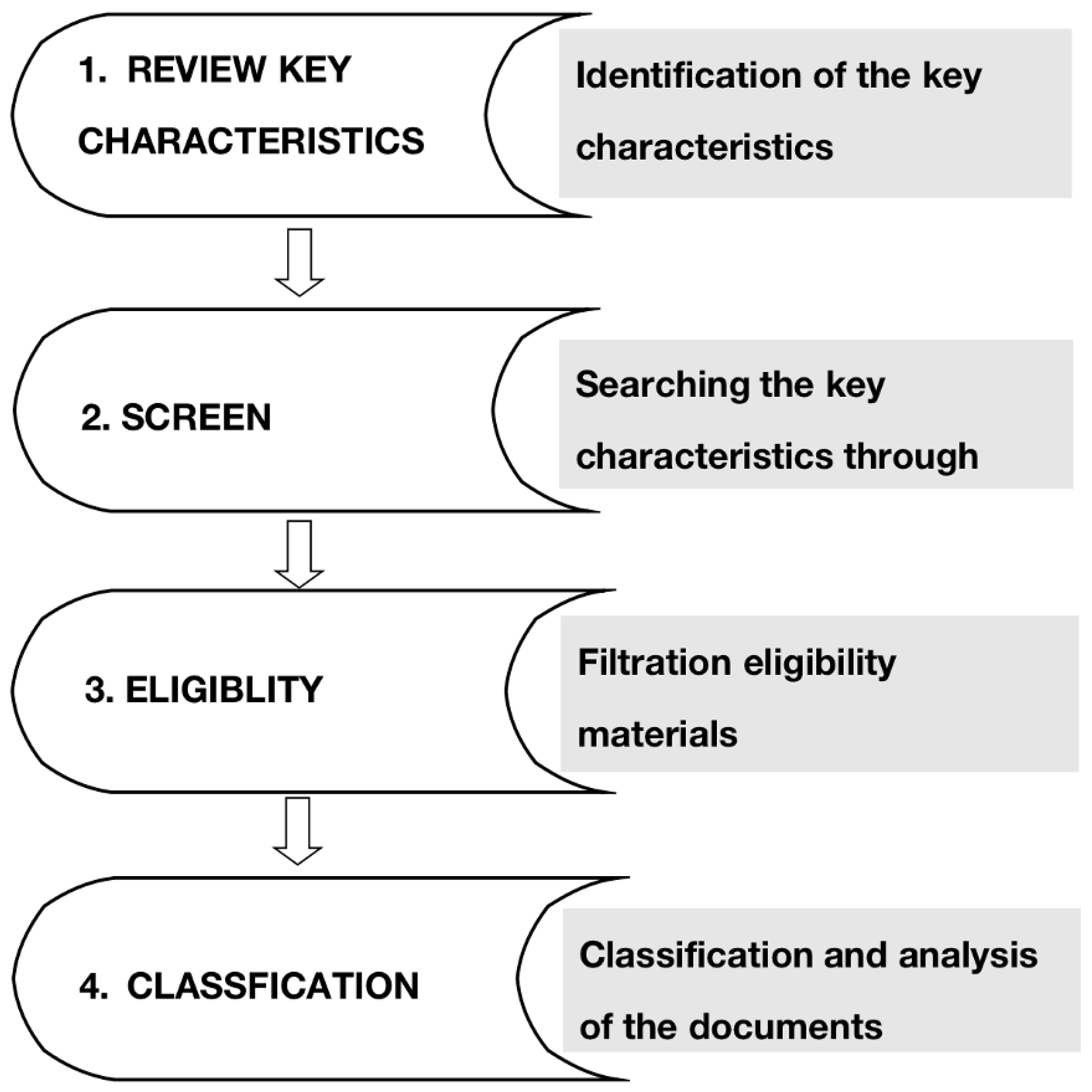
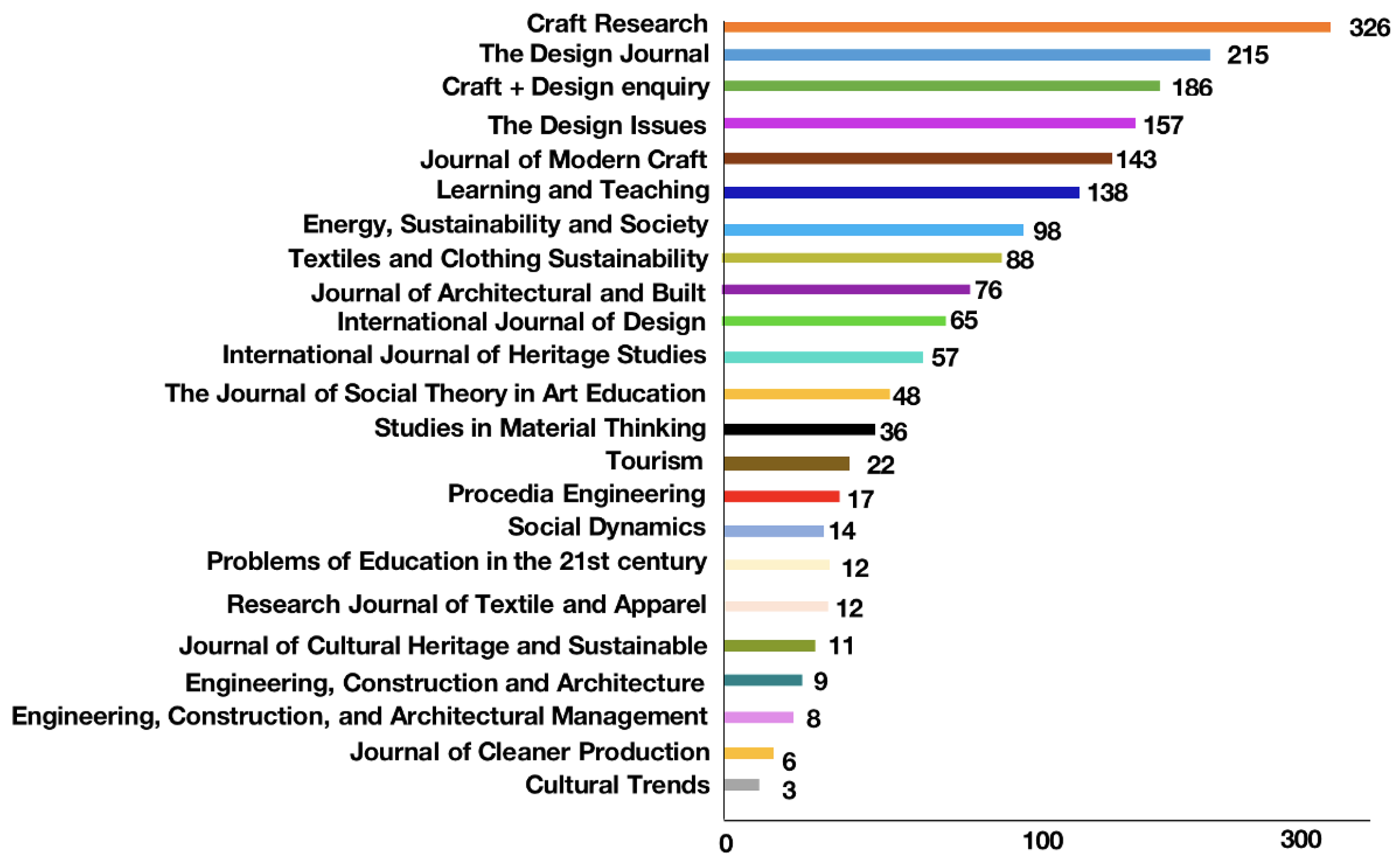
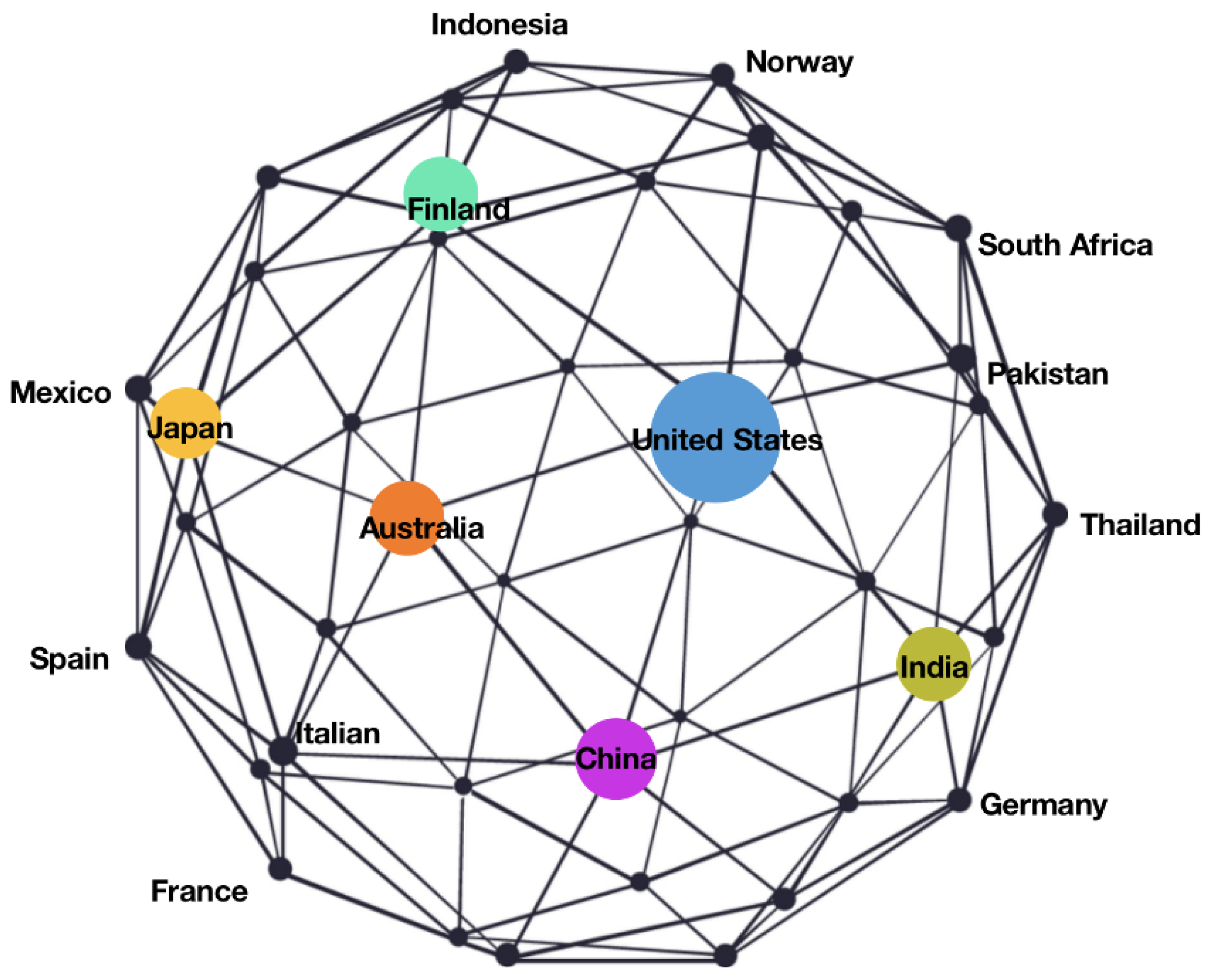
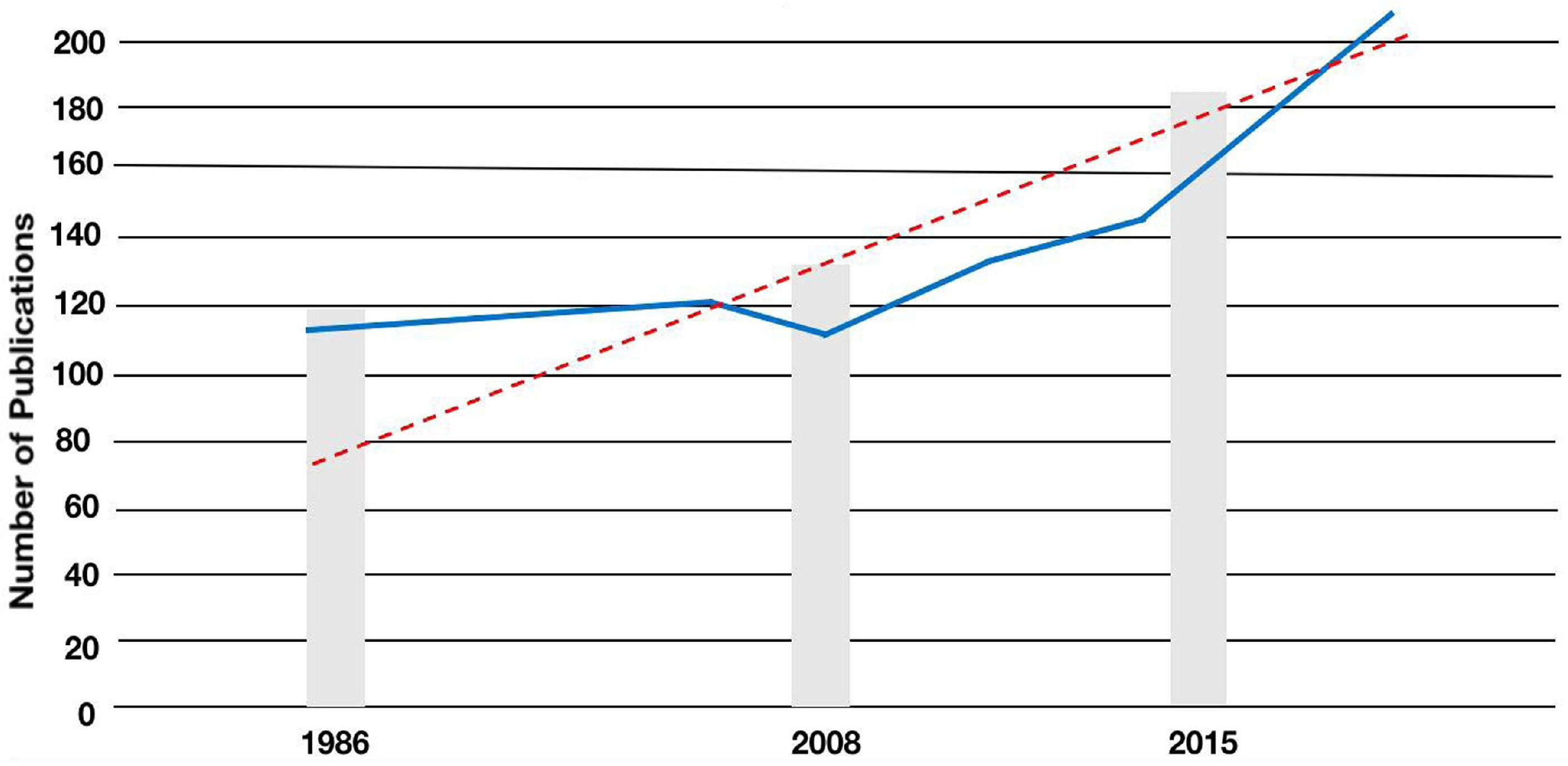
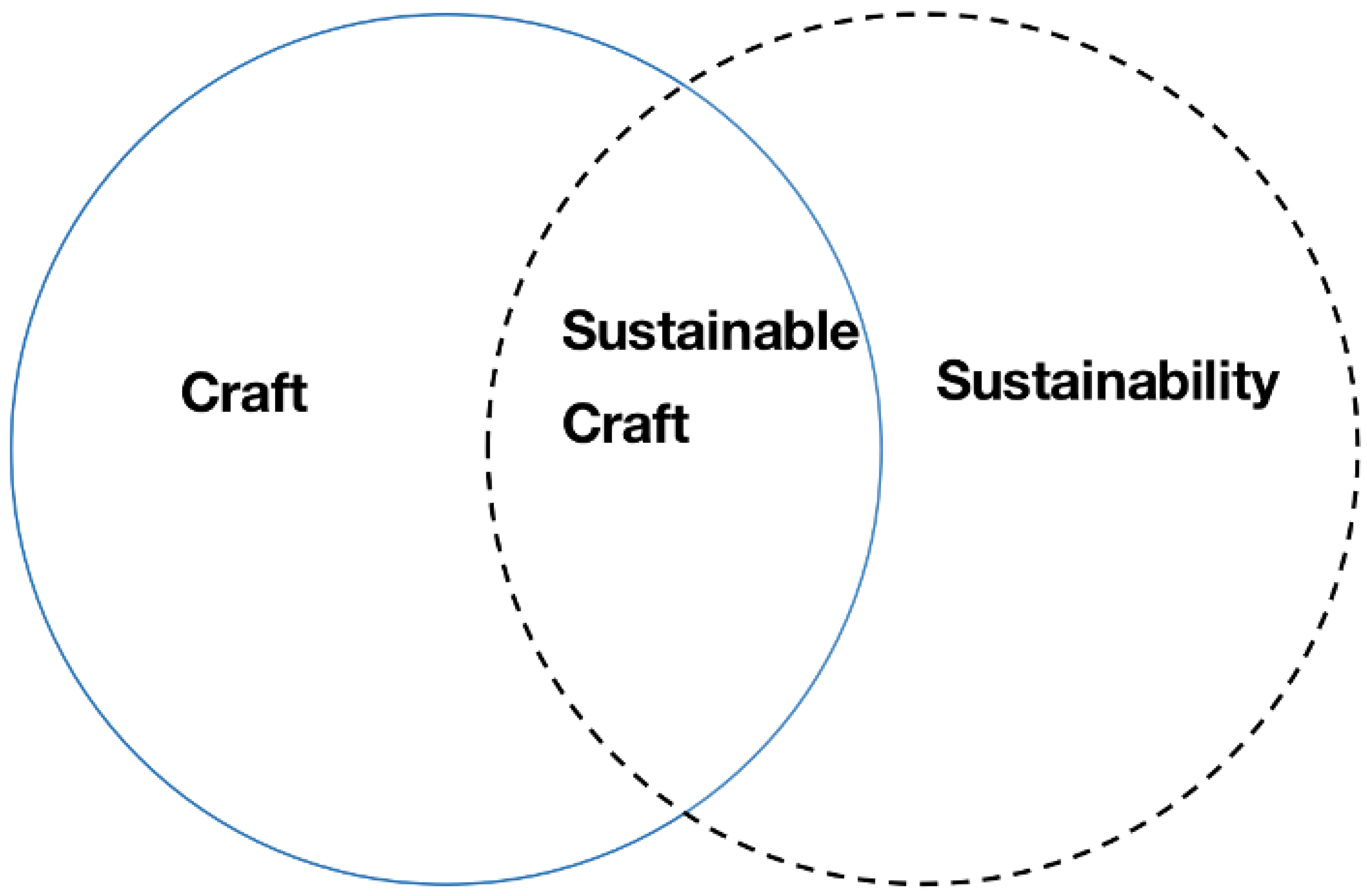
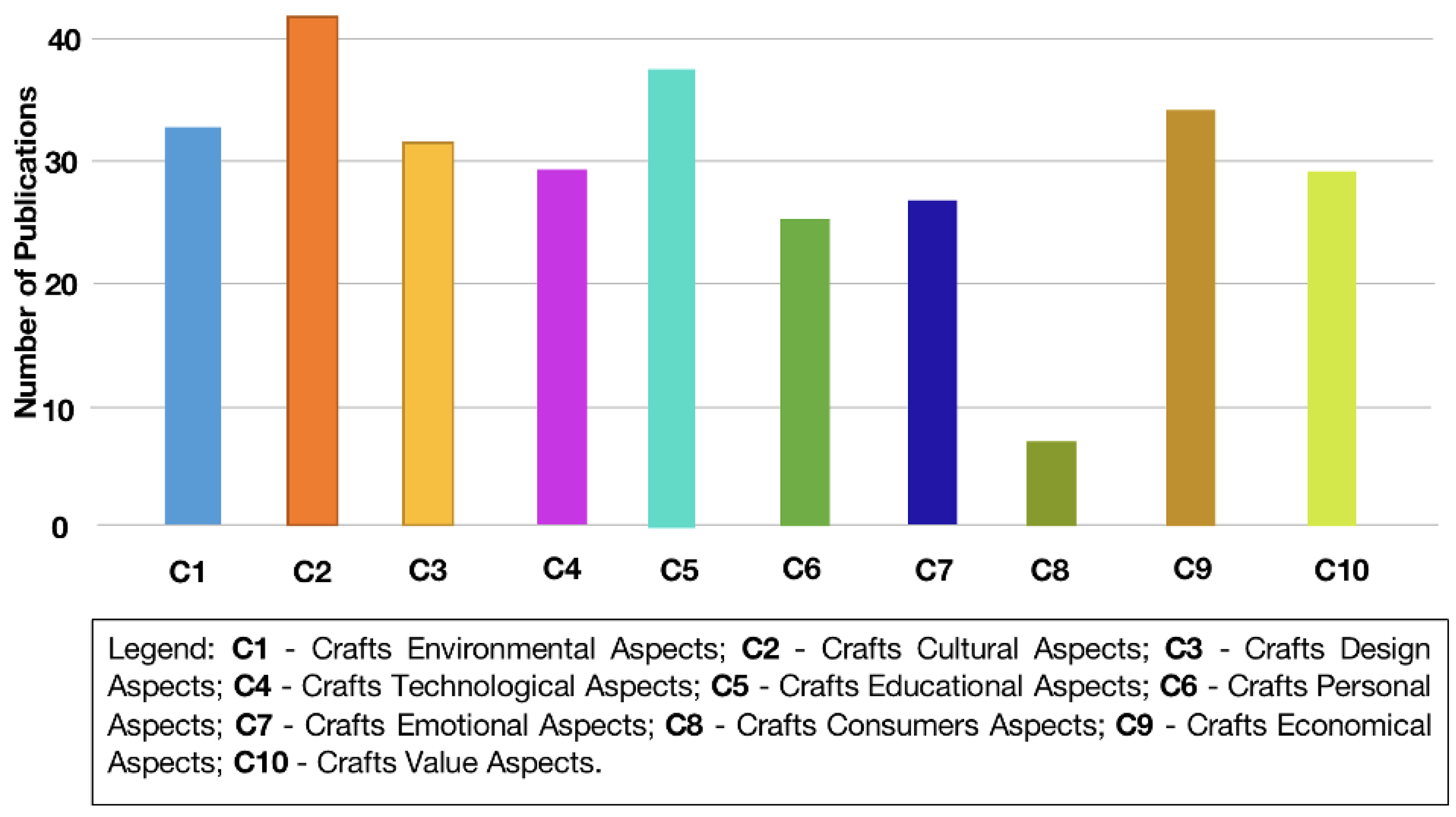
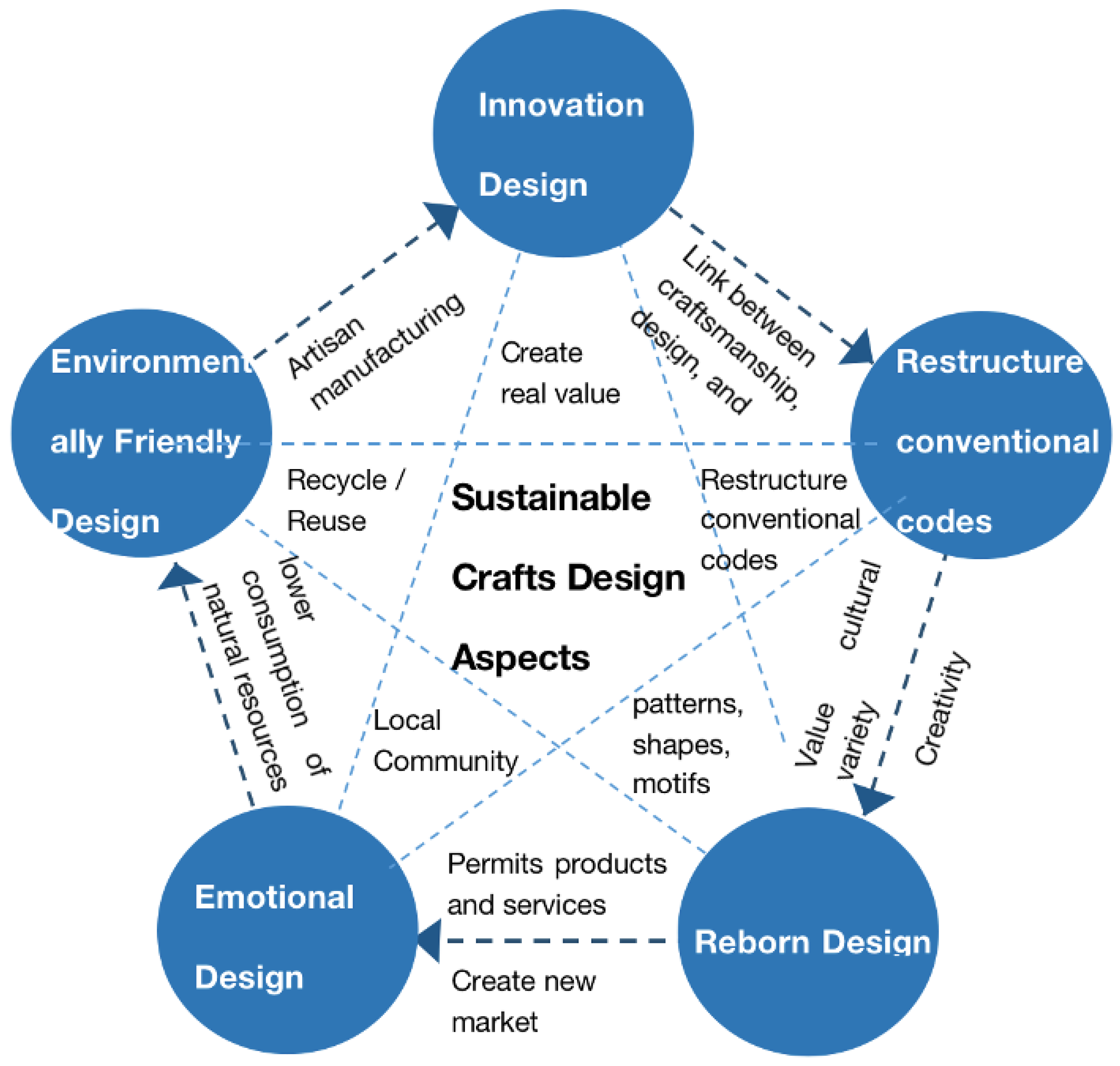
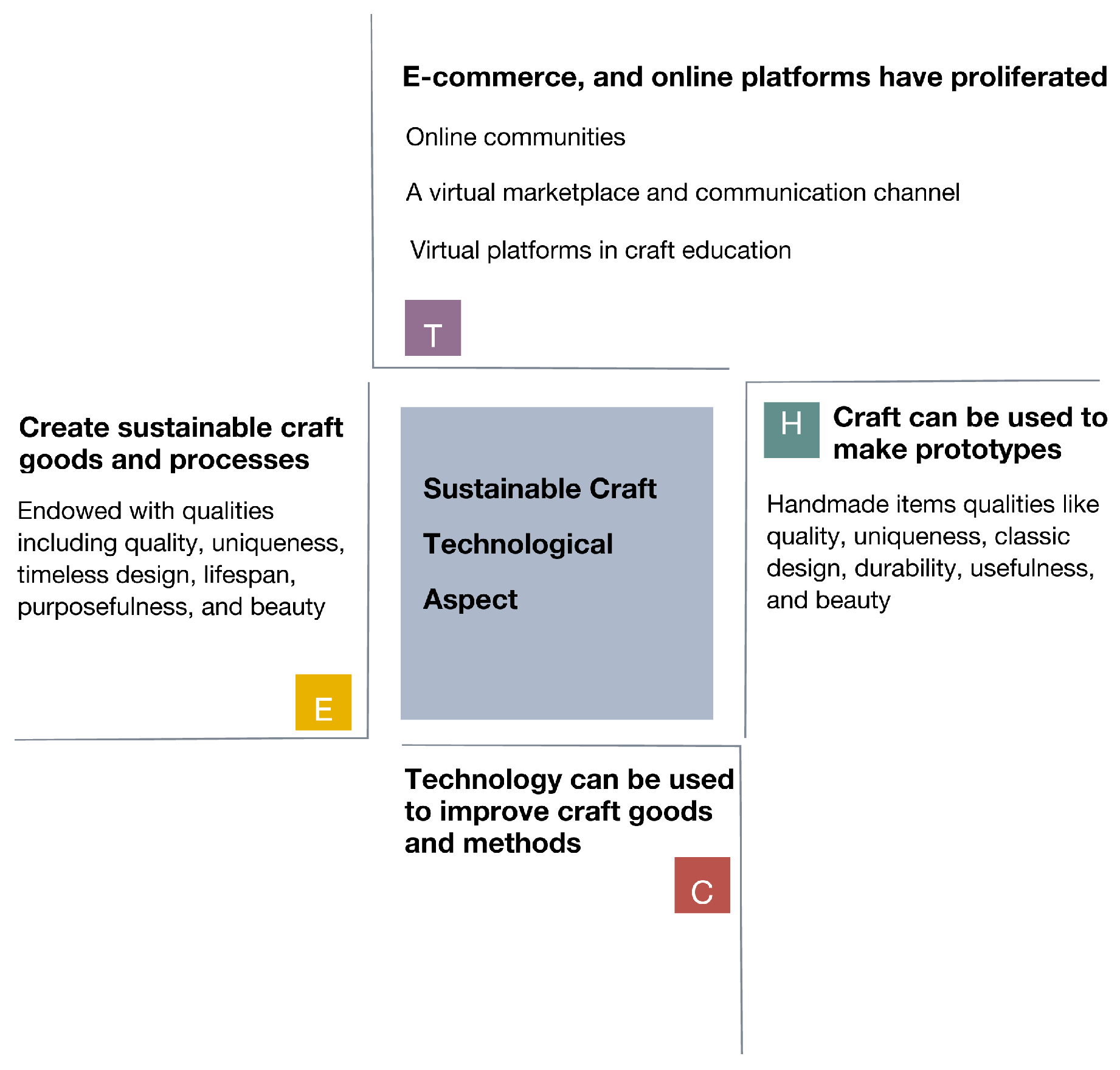
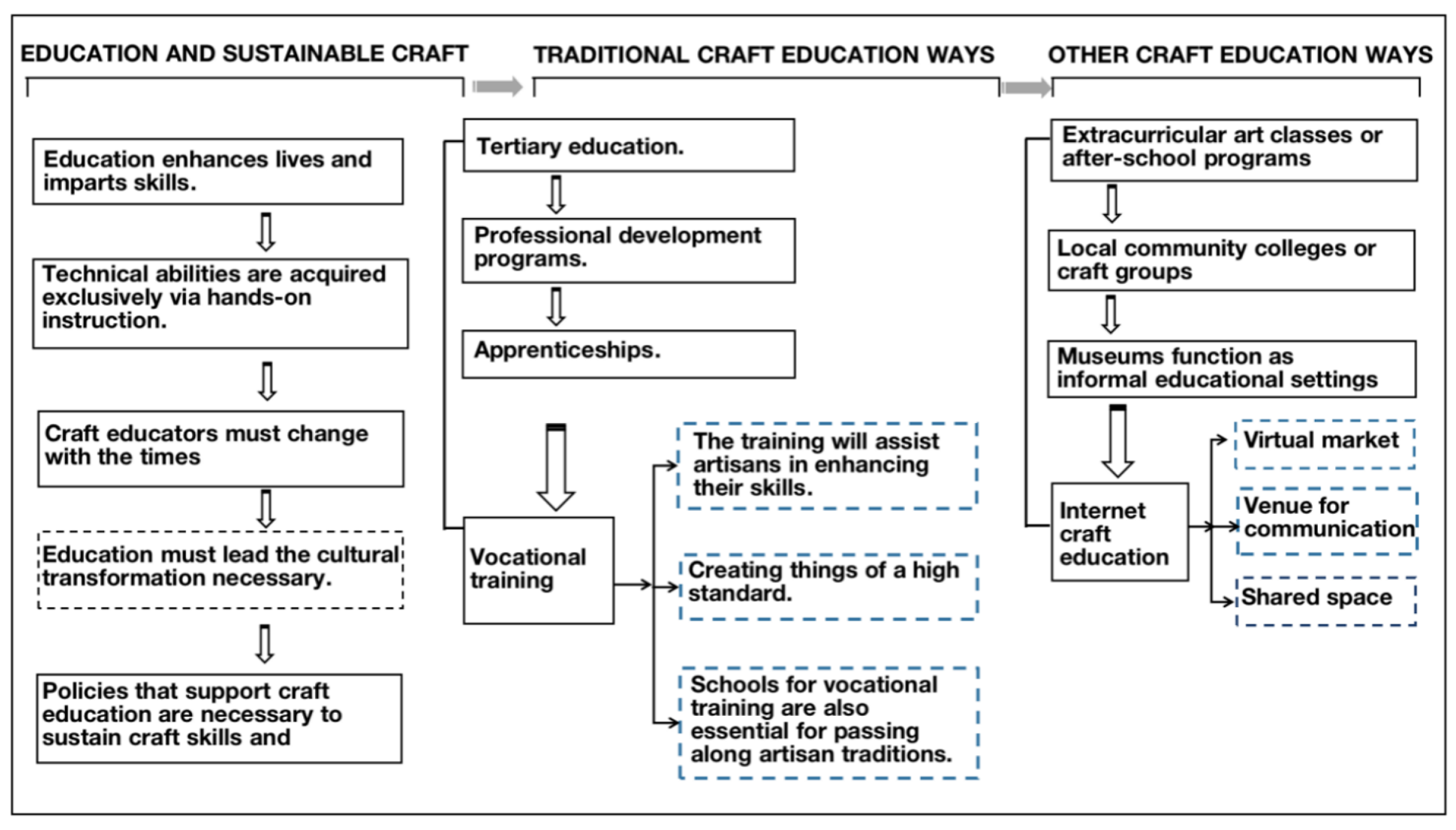
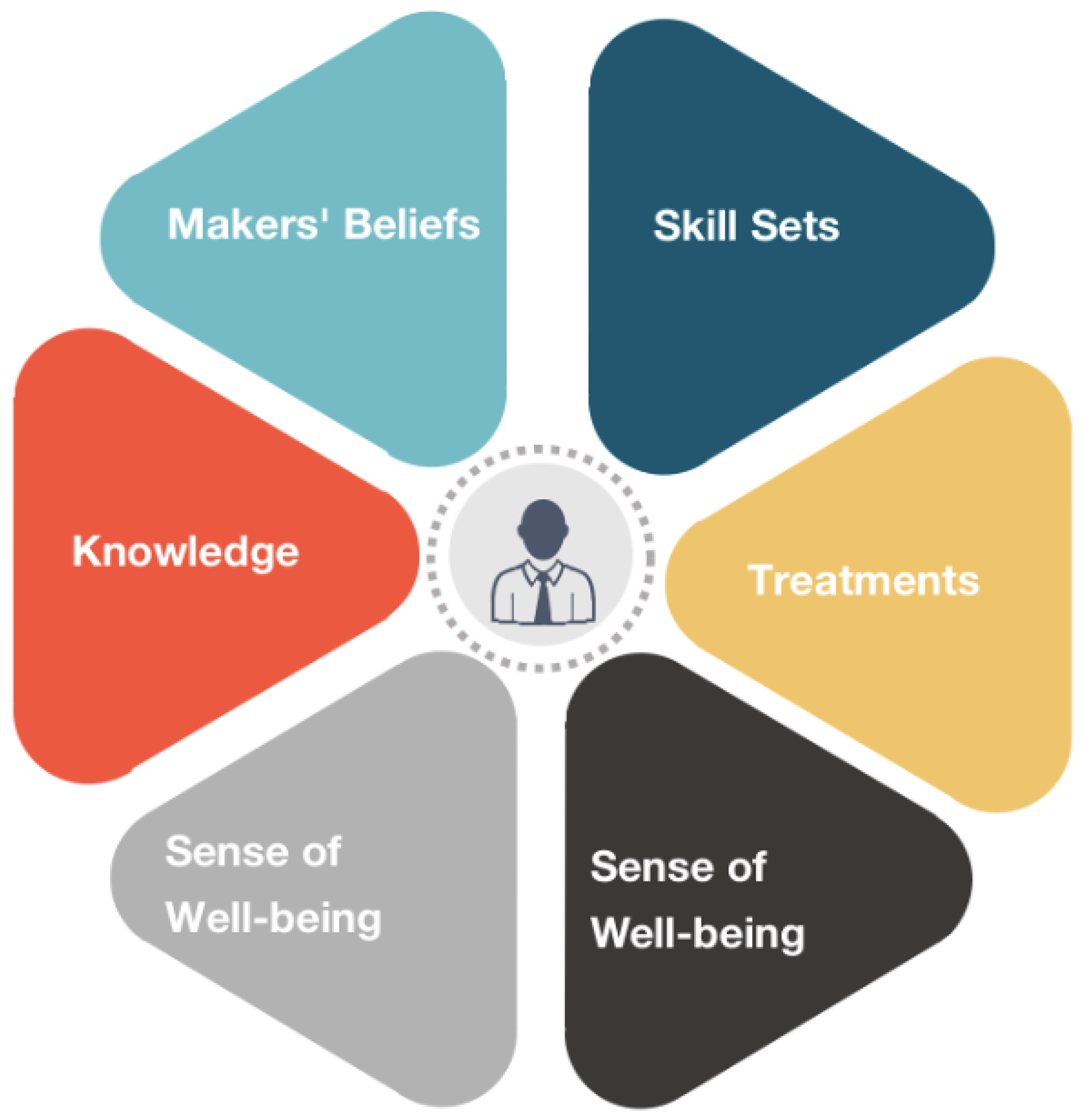
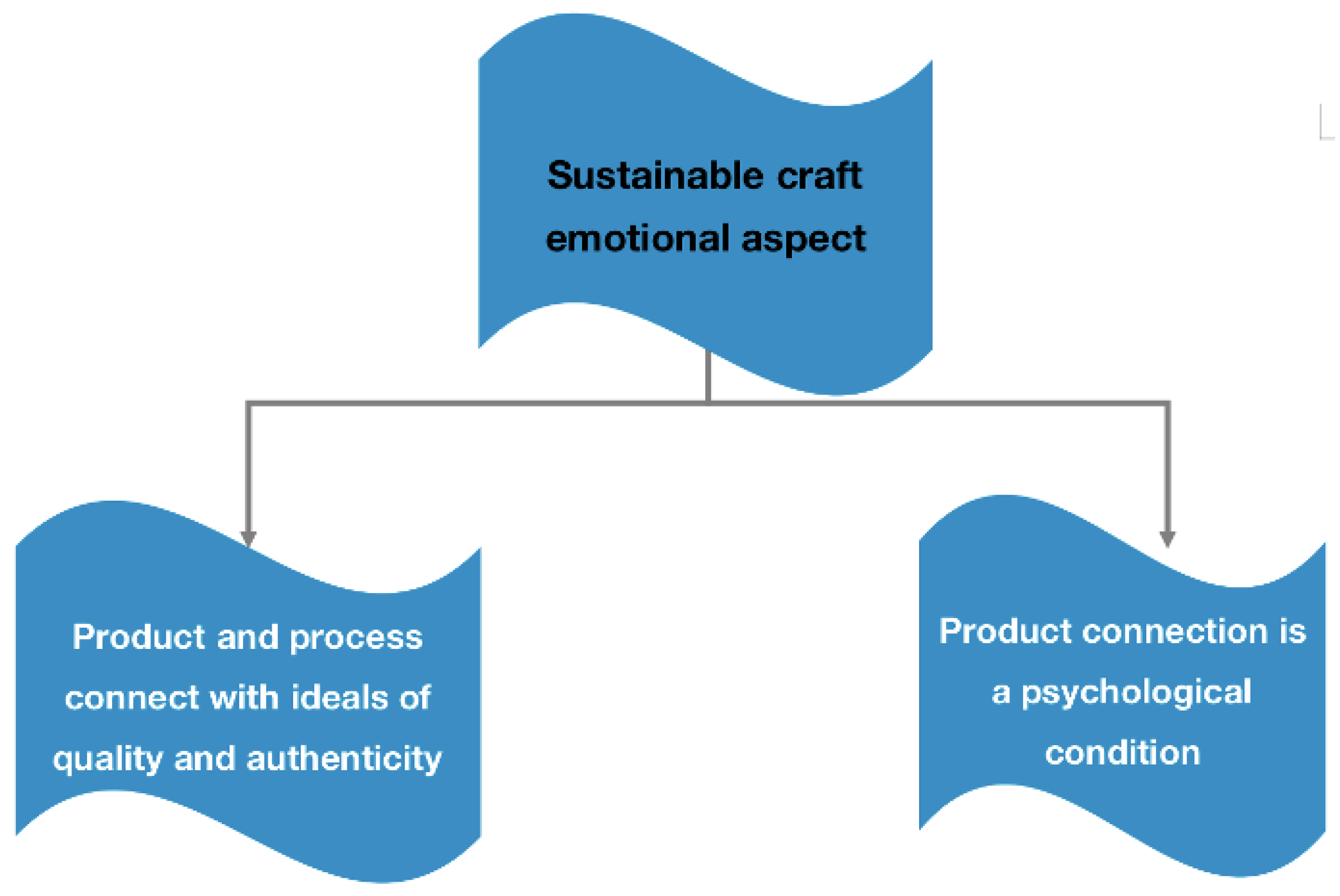
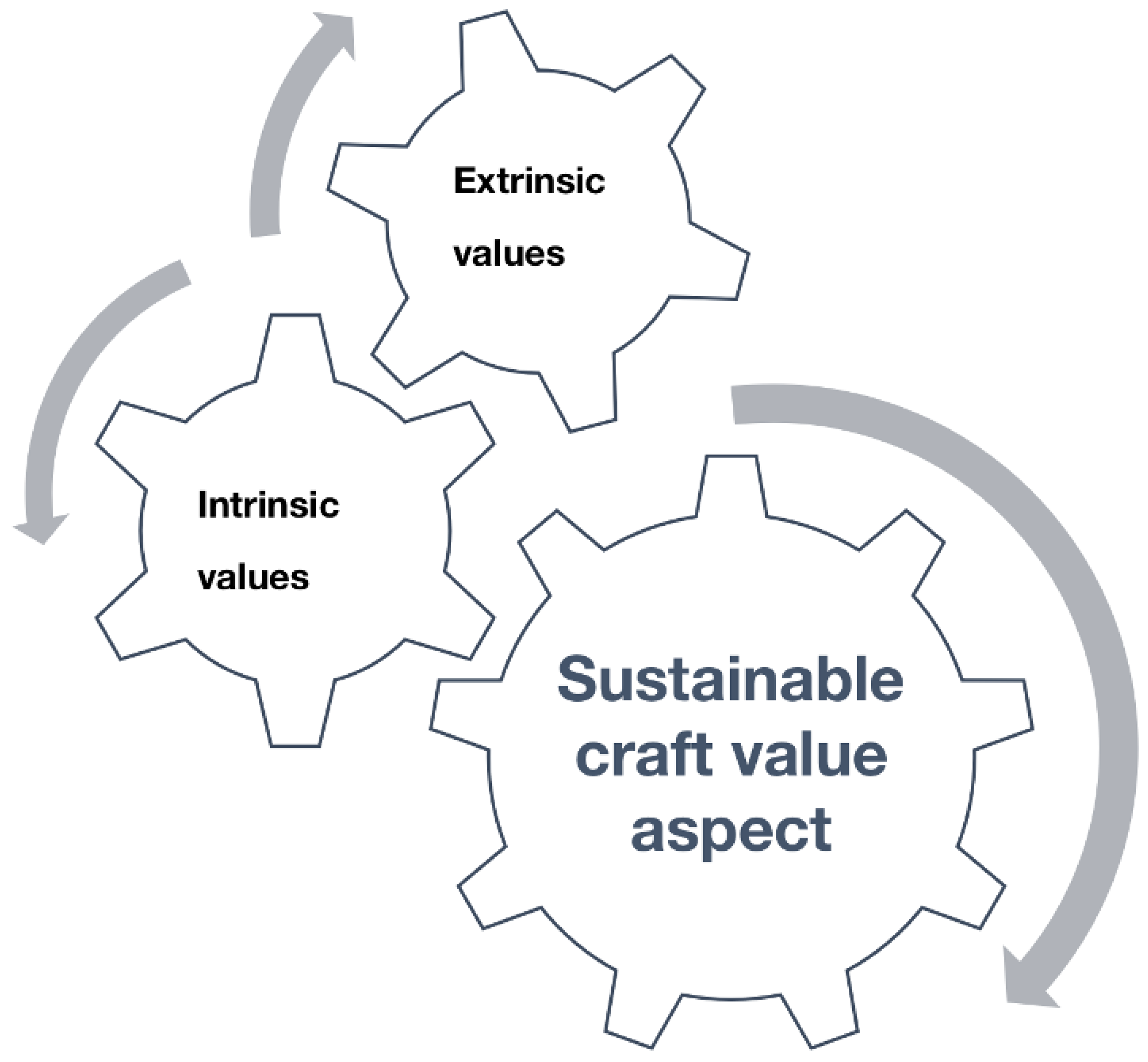
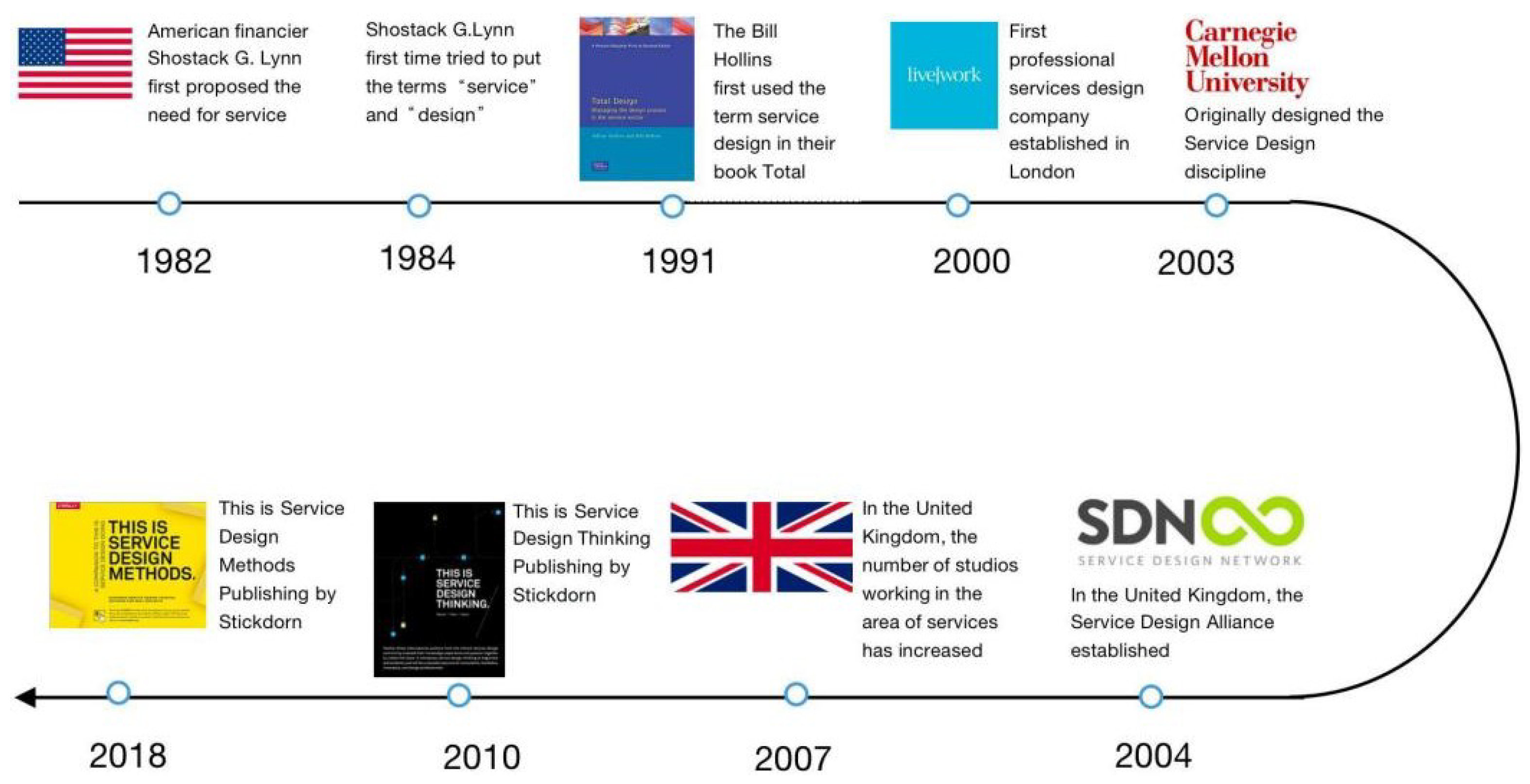
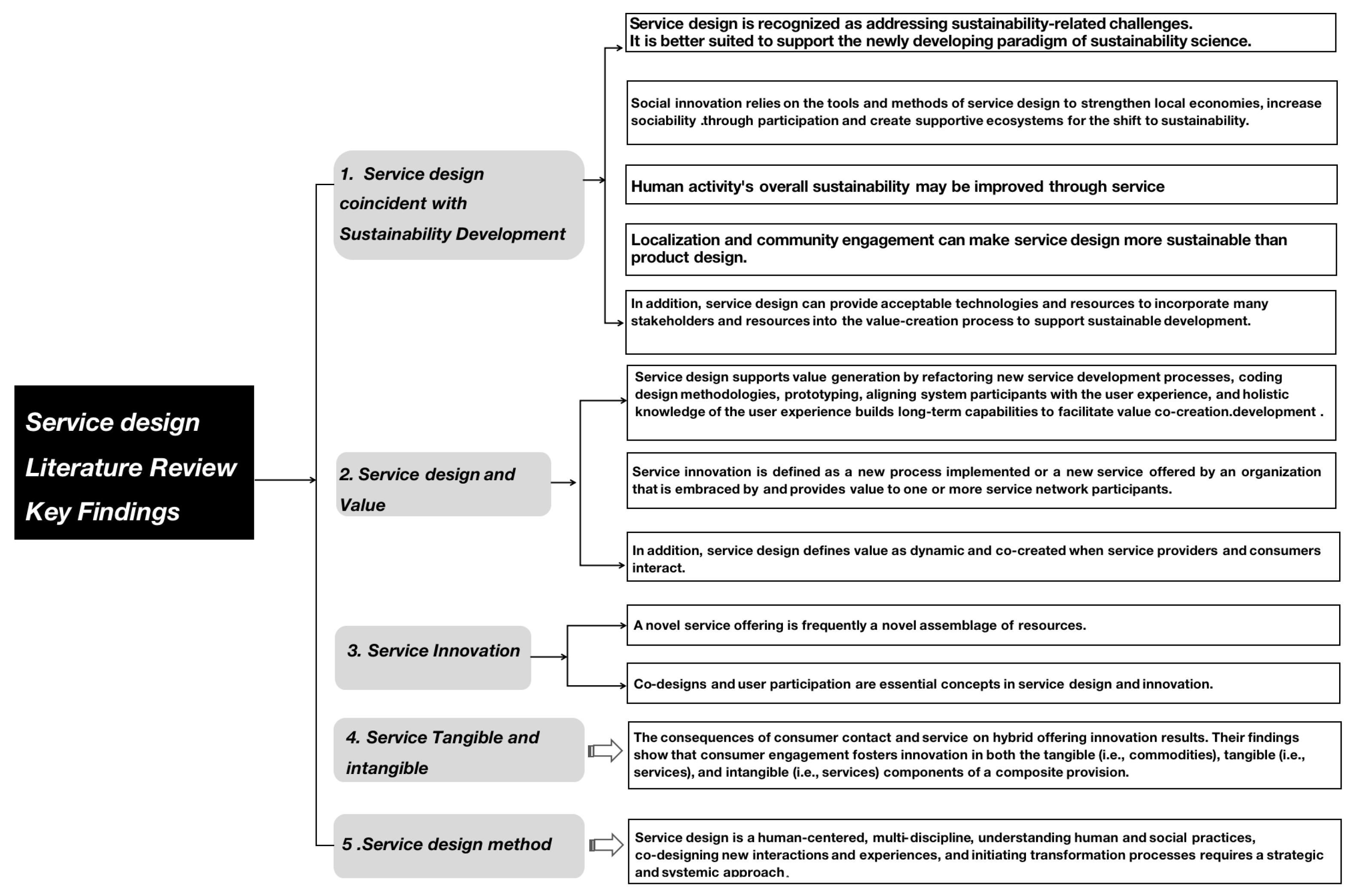
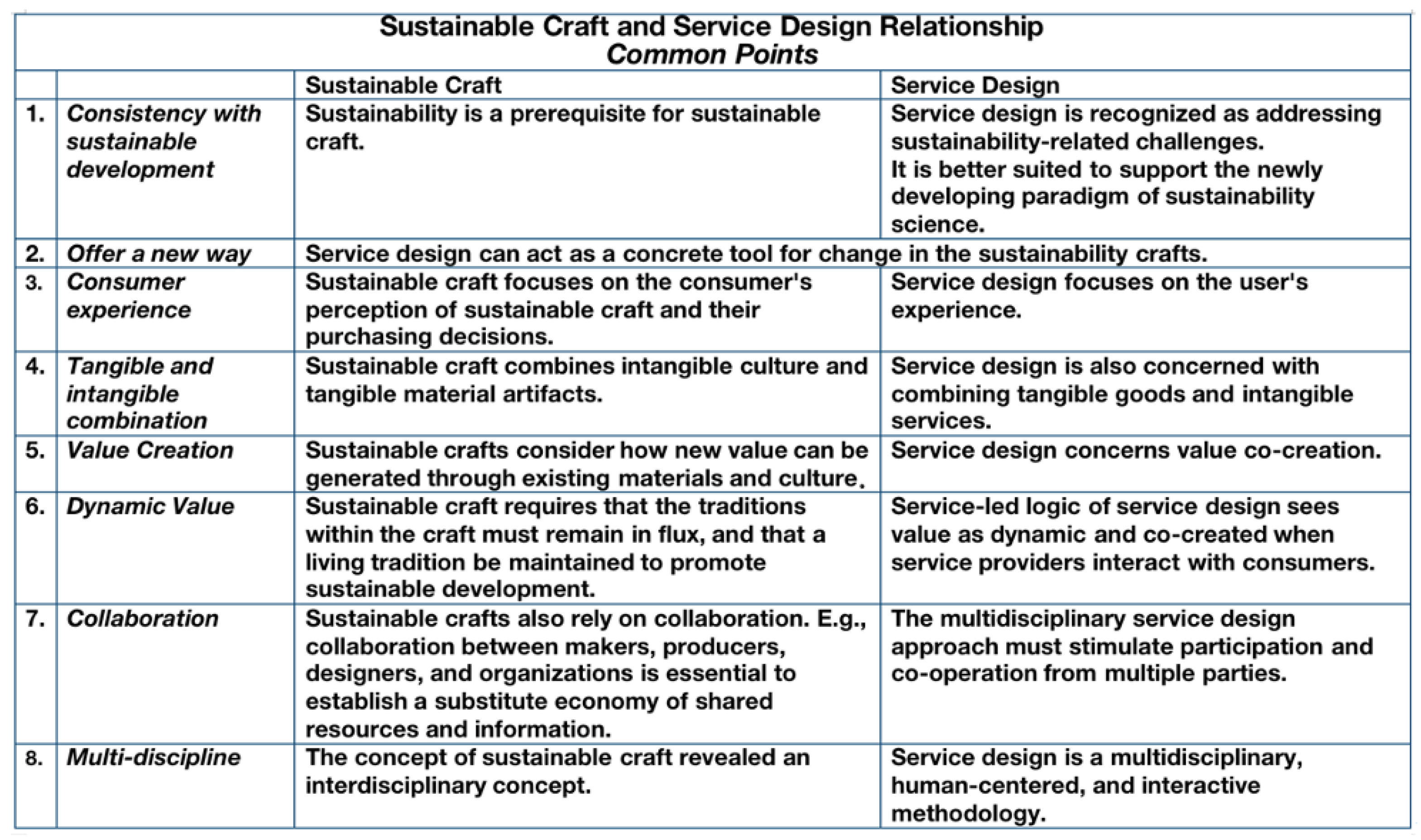
| Journal | Numbers | Country |
|---|---|---|
| Sustainability Switzerland | 33 | Switzerland |
| Design Journal | 13 | United Kingdom |
| Crafts Research | 12 | United Kingdom |
| Journal of Cleaner Production | 11 | United Kingdom |
| Wit Transactions on Ecology and the Environment | 8 | United Kingdom |
| African Journal of Hospitality Tourism and Leisure | 7 | South Africa |
| Journal of Modern Craft | 7 | United Kingdom |
| Economic Botany | 6 | United States |
| Forests, Trees and Livelihoods | 5 | United Kingdom |
| Indian Journal of Traditional Knowledge | 5 | India |
Disclaimer/Publisher’s Note: The statements, opinions and data contained in all publications are solely those of the individual author(s) and contributor(s) and not of MDPI and/or the editor(s). MDPI and/or the editor(s) disclaim responsibility for any injury to people or property resulting from any ideas, methods, instructions or products referred to in the content. |
© 2023 by the authors. Licensee MDPI, Basel, Switzerland. This article is an open access article distributed under the terms and conditions of the Creative Commons Attribution (CC BY) license (https://creativecommons.org/licenses/by/4.0/).
Share and Cite
Zhang, L.; de Bont, C.; Gurpinar, A.; Tang, M. An Exploration of the Relevance between Sustainable Craft and Service Design Based on a Literature Review Study. Sustainability 2023, 15, 16798. https://doi.org/10.3390/su152416798
Zhang L, de Bont C, Gurpinar A, Tang M. An Exploration of the Relevance between Sustainable Craft and Service Design Based on a Literature Review Study. Sustainability. 2023; 15(24):16798. https://doi.org/10.3390/su152416798
Chicago/Turabian StyleZhang, Li, Cees de Bont, Avsar Gurpinar, and Mingxi Tang. 2023. "An Exploration of the Relevance between Sustainable Craft and Service Design Based on a Literature Review Study" Sustainability 15, no. 24: 16798. https://doi.org/10.3390/su152416798
APA StyleZhang, L., de Bont, C., Gurpinar, A., & Tang, M. (2023). An Exploration of the Relevance between Sustainable Craft and Service Design Based on a Literature Review Study. Sustainability, 15(24), 16798. https://doi.org/10.3390/su152416798







